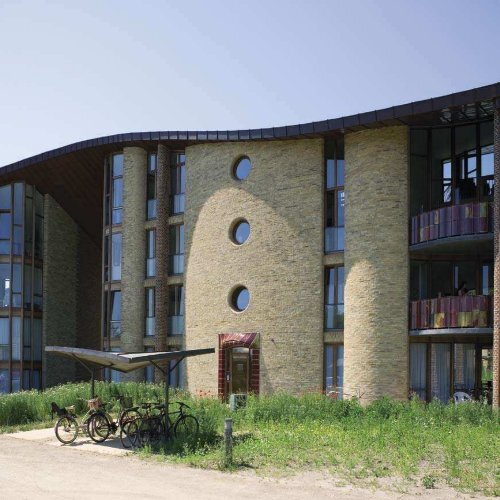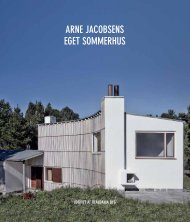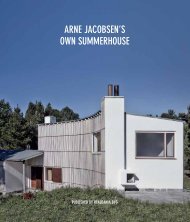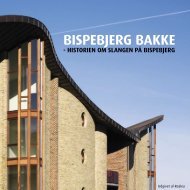the Vision of BispeBjerg Bakke - Realdania Byg
the Vision of BispeBjerg Bakke - Realdania Byg
the Vision of BispeBjerg Bakke - Realdania Byg
- No tags were found...
Create successful ePaper yourself
Turn your PDF publications into a flip-book with our unique Google optimized e-Paper software.
enough, it has led to modern, hi-tech solutions.<br />
At first glance, a clay model seems<br />
banal and elementary, but to be able to<br />
create <strong>the</strong> building expressed by <strong>the</strong> model,<br />
digital methods and systems, which<br />
have advanced <strong>the</strong> technical state <strong>of</strong> <strong>the</strong><br />
art, had to be developed. So <strong>the</strong> lump<br />
<strong>of</strong> clay has paradoxically made <strong>the</strong> project<br />
more innovative and complex than<br />
originally imagined. Over and above <strong>the</strong><br />
design process, <strong>the</strong> organic element is expressed<br />
in <strong>the</strong> winding, expressive body <strong>of</strong><br />
<strong>the</strong> building that forms a long ornamental<br />
progression. The building has been divided<br />
into modules, and in combination with <strong>the</strong><br />
ro<strong>of</strong>, which almost seems to gyrate, this<br />
generates a rhythm that harmonizes with<br />
<strong>the</strong> topography <strong>of</strong> <strong>the</strong> location. There was<br />
a desire to reintroduce <strong>the</strong> ornamental<br />
factor into construction; to create a visual<br />
readability that enables both residents and<br />
passers-by to relate to <strong>the</strong> architecture as<br />
pleasant and welcoming.<br />
How was <strong>the</strong> ambition to promote craftsmanship<br />
realized?<br />
It turned out somewhat differently than<br />
imagined in <strong>the</strong> beginning. I think one<br />
can safely say that <strong>the</strong>y had some ra<strong>the</strong>r<br />
romantic notions about <strong>the</strong> craftsmen<br />
producing everything on site as in <strong>the</strong><br />
old days. But <strong>the</strong> project has been continuously<br />
adjusted – for example by abandoning<br />
<strong>the</strong> idea <strong>of</strong> using full-brick walls<br />
without prefabricated sections. However,<br />
<strong>the</strong> goal <strong>of</strong> placing craftsmanship strongly<br />
in <strong>the</strong> centre <strong>of</strong> <strong>the</strong> picture throughout<br />
<strong>the</strong> construction has not been lost.<br />
One could argue that some symbolic significance<br />
has been lost by using brick facing,<br />
but on <strong>the</strong> o<strong>the</strong>r hand this change <strong>of</strong><br />
plans led to devising a new way <strong>of</strong> producing<br />
concrete elements, and it has been<br />
done in a way that remains faithful to <strong>the</strong><br />
original design. At <strong>the</strong> same time, <strong>the</strong><br />
copper ro<strong>of</strong> is one example <strong>of</strong> how traditional<br />
craftsmanship has been carried<br />
forward and developed, <strong>the</strong>reby demon-<br />
102 103
















